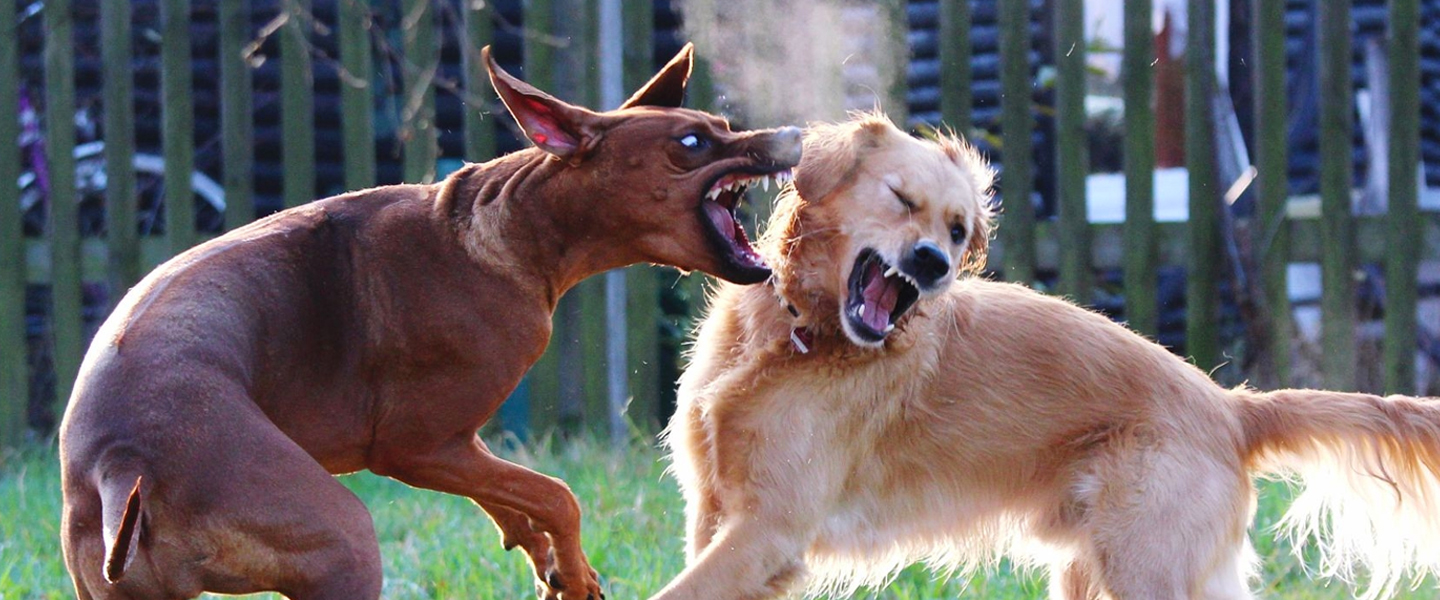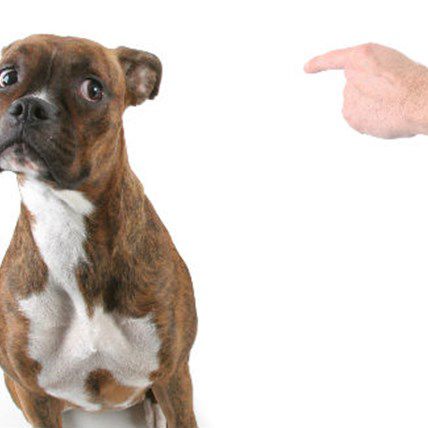To stop a dog fight with one finger, firmly press the top of the dog’s nose. This causes the dog to release its grip on the other dog, effectively stopping the fight.
When a dog fight breaks out, it can be a scary and intense situation. Whether you are a pet owner, dog walker, or simply someone in the vicinity, knowing how to quickly and safely stop a dog fight is crucial.
Using the one-finger method can help prevent serious injuries to the dogs and those nearby. We will explore the reasons behind dog fights, the correct approach to stopping them, and preventive measures to avoid future conflicts. By understanding and implementing these strategies, you can ensure the safety and well-being of the dogs and those around them.

Credit: www.cesarsway.com
Recognizing Aggressive Behavior
When it comes to preventing dog fights, one of the crucial skills you need is recognizing aggressive behavior. Understanding the body language of dogs and spotting warning signs can help you intervene quickly and prevent potential conflict. By paying close attention to their behavior, you can be proactive in maintaining a safe and peaceful environment for your furry friends.
Understanding Body Language
Dogs have their own unique way of communicating, and it’s important to be familiar with their body language to interpret their intentions. Here are some key cues to look out for:
- Stiff body: When a dog’s body becomes rigid, it may indicate tension and potential aggression.
- Intense eye contact: Locked eye contact can be a sign of dominance or aggression.
- Growling or snarling: Audible warnings such as growls or snarls should never be ignored.
- Exposed teeth or raised hackles: These physical changes suggest the dog is ready to defend itself or attack.
Spotting Warning Signs
Recognizing warning signs of aggression is crucial in preventing dog fights. By being attentive to these signs, you can take appropriate action to diffuse the situation. Here are some common warning signs:
- Mounting: In canine social interactions, mounting can be a sign of dominance and potential aggression.
- Excessive barking or lunging: Dogs who repeatedly bark or lunge are often displaying territorial or protective behavior.
- Escalating tension: If you notice that the interaction between two dogs is becoming increasingly intense or heated, it’s time to intervene.
- Guarding possessions: Dogs may become defensive when other animals approach their food, toys, or personal space.
- Snapping or nipping: These swift and aggressive movements can escalate into a full-blown fight if left unaddressed.
Being able to identify the signs of aggression allows you to react promptly and prevent potential conflicts. Remember, early intervention is key in maintaining a harmonious environment for your canine companions.

Credit: www.wikihow.pet
Preventing Dog Fights
As a responsible dog owner, preventing dog fights should be a top priority. Understanding the triggers and knowing how to de-escalate high-tension situations can make all the difference in keeping your furry friends safe. Here are some effective strategies to prevent dog fights and maintain a peaceful environment for your pets.
Avoiding High Tension Areas
Avoiding areas with high levels of stress and tension can significantly reduce the likelihood of dog fights. Whether it’s a crowded dog park or a busy street, recognize the potential triggers and proactively steer clear of these situations. Providing your dogs with a calm and controlled environment can greatly minimize the risk of conflict.
Using Positive Reinforcement
Implementing positive reinforcement techniques can promote good behavior and decrease the likelihood of aggression. By rewarding your dogs for calm interactions and obedience, you can encourage positive habits and discourage aggressive tendencies. Consistent and positive interactions can contribute to a harmonious relationship between your dogs and prevent potential conflicts.
Intervening In A Dog Fight
Intervening in a Dog Fight requires quick thinking and calm actions. It’s important to always prioritize safety and avoid putting oneself in harm’s way. Assessing the situation is crucial in order to effectively use the ‘One Finger’ technique to stop a dog fight.
Assessing The Situation
When encountering a dog fight, it’s essential to stay calm and carefully evaluate the situation. Check for potential dangers and avoid jumping into the midst of the fight. Assess the dogs’ body language and determine the level of aggression to plan the appropriate intervention strategy.
Using The ‘one Finger’ Technique
The ‘One Finger’ technique involves using a calm and authoritative approach to stop a dog fight. By firmly placing your index finger in the dogs’ collar, it disrupts their focus and can help break their attention from the fight. This method should be executed swiftly and decisively while maintaining a composed demeanor.

Credit: melmagazine.com
Additional Safety Tips
In addition to knowing how to stop a dog fight with one finger, there are a few additional safety tips that can help ensure the well-being of both you and the dogs involved. By staying calm and avoiding panic, you can effectively deescalate the situation. Calling for professional help is also crucial in handling a dog fight safely. These tips can help prevent any further harm and provide a safe resolution.
Keeping Calm And Avoiding Panic
Keeping calm during a dog fight is essential as panicking can escalate the situation further. It’s important to remember that dogs can sense fear and high stress levels, which can intensify their aggression. Stay composed and approach the dogs in a confident and assertive manner. Avoid shouting or making sudden movements. Instead, speak in a calm and soothing tone to help alleviate tension.
Calling For Professional Help
If you find yourself in a situation where you are unable to stop the dog fight alone, it’s imperative to reach out for professional help. Keep emergency phone numbers for local animal control agencies or professional dog trainers readily available. They have the expertise and tools to handle dog fights safely. Avoid attempting to physically intervene or separate the dogs yourself, as this can result in injuries to you or the dogs.
Remember, the safety of all those involved is paramount. By adhering to these additional safety tips, you can effectively manage a dog fight while minimizing risks. Stay calm, call for professional help, and prioritize the well-being of both the dogs and yourself.
Post-fight Care
Discover the secrets to stopping a dog fight using just your finger. Learn effective post-fight care techniques in this informative guide. Keep your furry friends safe with this simple and efficient method.
After successfully stopping a dog fight with just one finger, it’s vital to proceed with proper post-fight care. The aftermath of a dog fight can leave physical and emotional scars on both dogs involved. Providing first aid and addressing emotional stress are essential steps to ensure the well-being and recovery of your pet. Let’s explore these crucial aspects in detail.Providing First Aid
When it comes to post-fight care, providing immediate first aid is of utmost importance. Remember, assessing and treating any injuries should be done with caution to avoid further harm or agitation.- Begin by separating the dogs to prevent any further confrontations.
- Inspect your dog for any visible wounds, such as scratches, bites, or puncture wounds.
- If there are minor superficial wounds, clean them gently but thoroughly with an antiseptic solution.
- Apply an appropriate wound dressing, such as a sterile gauze pad, to control bleeding and protect the wound.
- For deeper or more severe wounds, it’s best to consult a veterinarian for professional care.
- Keep an eye out for signs of infection, like redness, swelling, or discharge, and seek veterinary attention if necessary.
Addressing Emotional Stress
Aside from physical injuries, dog fights can cause significant emotional distress to both dogs involved. Addressing emotional stress is crucial for their well-being and to prevent any future aggression or behavioral issues.- Ensure a calm and quiet environment for your dog in the aftermath of a fight.
- Provide a safe space, such as a designated crate or a separate room, where the dog can recuperate and feel secure.
- Offer plenty of fresh water and a comfortable resting place to help promote relaxation.
- Monitor your dog’s behavior closely for signs of anxiety, aggression, or fear following the incident.
- If you notice any concerning behavioral changes, consider consulting with a professional dog trainer or behaviorist.
- Be mindful not to reinforce any aggressive behaviors by comforting or rewarding the dog excessively.
Frequently Asked Questions On How To Stop A Dog Fight With One Finger
How Do You Stop A Dog Fight?
To stop a dog fight, never use your hands or try to separate them directly. Instead, make a loud noise or use a distracting object to divert their attention. You can also use water to separate them or throw a heavy blanket over them to interrupt the fight.
It’s crucial to seek professional help if the fights persist.
Why Do Dogs Fight?
Dogs may fight due to various reasons, such as resource guarding, territorial disputes, fear, or social hierarchy issues. Lack of proper socialization or training can also contribute to aggressive behavior. Identifying the underlying cause and addressing it through training, behavior modification, or seeking professional help can help prevent canine fights.
How Can You Prevent Dog Fights?
Preventing dog fights involves proactive measures like proper socialization and training from an early age. Spaying or neutering your pets can reduce aggression. Avoid putting dogs in stressful situations or overcrowded environments. Additionally, always supervise their interactions, provide enough mental and physical stimulation, and address any signs of aggression promptly.
Can Dogs Fight To The Death?
While rare, dogs can fight to the death if left uncontrolled and unaddressed. Severe injuries, such as puncture wounds or internal damage, can be fatal. It is essential to intervene early and effectively manage any signs of aggression to prevent such extreme outcomes.
Seeking professional help and implementing proper prevention strategies are crucial.
Conclusion
Mastering the one-finger technique can be a game-changer when it comes to stopping dog fights quickly and efficiently. It not only ensures the safety of the dogs involved but also prevents severe injuries. Remember, practice makes perfect, so take the time to familiarize yourself with this technique.
With a calm and confident approach, you’ll be equipped to intervene effectively and keep pooches out of harm’s way. Happy dog parenting!



